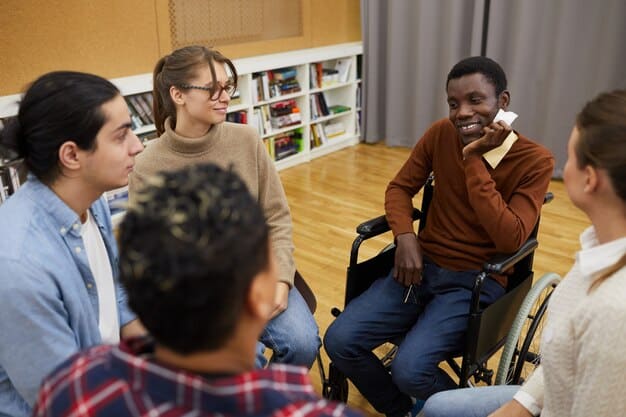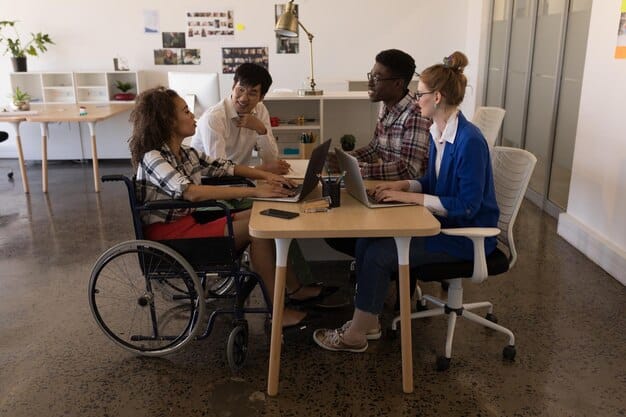Promoting Inclusive Education for Students with Disabilities: A Path Forward

Achieving genuinely inclusive education for students with disabilities transcends mere physical presence, demanding a systemic overhaul of pedagogical approaches, resource allocation, and societal perceptions to ensure equitable access and meaningful participation for every learner.
The journey towards a truly equitable educational landscape is one that requires constant introspection, innovation, and commitment. For students with disabilities, this journey often presents unique challenges and opportunities. Understanding how can we promote inclusive education for students with disabilities is not just an academic exercise; it’s a moral imperative that shapes the future of our societies. This article delves into the multi-faceted strategies and foundational shifts necessary to create learning environments where every student, regardless of ability, can thrive.
Understanding the Foundations of Inclusive Education
Inclusive education is more than just placing students with disabilities in general education classrooms. It’s a philosophical approach rooted in the belief that all children, regardless of their abilities or disabilities, have the right to learn together, to the maximum extent appropriate. This involves a fundamental shift from traditional models that often segregated students based on perceived limitations, towards systems that celebrate diversity and recognize the unique contributions each learner brings to the educational ecosystem. The historical context of special education has seen a transition from institutionalization and segregation to mainstreaming, and then to full inclusion. This evolution reflects a growing understanding of human rights and the profound benefits that diverse environments offer to all participants.
A core tenet of inclusive education is the recognition that disability is often a social construct, influenced by environmental and attitudinal barriers, rather than solely an individual medical condition. When we talk about how to promote inclusive education, we are inherently discussing the dismantling of these barriers. This requires a proactive approach to identifying and removing obstacles within the curriculum, physical spaces, teaching methods, and school culture itself. It is about creating a system where diverse learners feel valued, safe, and empowered to reach their full potential. This includes providing appropriate accommodations, modifications, and support services tailored to individual needs, without isolating students from their peers.
From Integration to Inclusion: A Paradigm Shift
The distinction between integration and inclusion is crucial for understanding effective practice. Integration often implies that students with disabilities are “fit into” existing structures, sometimes with minimal adaptations. Inclusion, conversely, means transforming the entire system to accommodate and celebrate diversity from the outset, ensuring that all students belong and are actively participating.
- Integration: Students with disabilities are placed in mainstream settings, but the system may not fundamentally change to meet their needs.
- Inclusion: The school system adapts its structures, curricula, and teaching methods to embrace and support all students.
- Belonging: Key to true inclusion, ensuring students feel a part of the school community, not just present within it.
- Participation: Active engagement in all aspects of school life, academic and social.
Ultimately, promoting inclusive education means rethinking what education means for every child. It’s about building a compassionate, responsive, and effective system that serves all learners, acknowledging their individual strengths and challenges, and fostering an environment of mutual respect and understanding.
Crafting Responsive Curricula and Pedagogies
The cornerstone of effective inclusive education lies in the adaptability and flexibility of the curriculum and teaching methods. A one-size-fits-all approach is inherently exclusive and fails to cater to the diverse learning styles, paces, and needs of students with disabilities. Therefore, rethinking curriculum design and pedagogical strategies is paramount. This involves moving beyond traditional lecture-based methods to embrace approaches that are engaging, multi-modal, and accessible to a broad spectrum of learners. Universal Design for Learning (UDL) emerges as a critical framework in this context, offering principles for designing educational environments that are inherently flexible and inclusive from the start.
UDL isn’t about retrofitting accommodations; it’s about proactively building options into the curriculum that anticipate the diverse needs of all students. This means providing multiple means of representation (how content is presented), multiple means of action and expression (how students demonstrate understanding), and multiple means of engagement (how students are motivated and challenged). When teachers are equipped with UDL principles, they can design lessons that appeal to visual learners, auditory learners, kinesthetic learners, and those who benefit from varied ways of interacting with material. This significantly reduces the need for individualized modifications down the line, as the initial design is already inclusive.
Universal Design for Learning (UDL) in Practice
Implementing UDL requires a shift in mindset for educators. It’s about seeing barriers not within the student, but within the design of the learning environment. By offering a variety of methods for students to access information, express their knowledge, and feel motivated, UDL ensures a robust and equitable learning experience for everyone.
- Provide multiple means of representation: Present information in varied formats like text, audio, video, graphics, and hands-on activities.
- Offer multiple means of action and expression: Allow students to demonstrate learning through different modalities such as writing, speaking, drawing, creating models, or performing.
- Engage with multiple means of engagement: Foster motivation by offering choices, promoting collaboration, and making learning relevant to students’ lives.
Furthermore, differentiated instruction plays a vital role within this framework. Teachers adapt content, process, products, and learning environments to meet individual student needs. This might involve providing tiered assignments, offering flexible grouping options, or adjusting the complexity of tasks. The goal is to maximize student growth and individual success by meeting students where they are and guiding them forward. These pedagogical adjustments, when implemented thoughtfully, ensure that the curriculum remains challenging but also attainable for all learners.
Fostering a Culture of Support and Collaboration
The successful promotion of inclusive education depends heavily on creating a school culture that prioritizes support, understanding, and collaboration among all stakeholders. This extends beyond the classroom to encompass the entire school community, including administrators, teachers, support staff, parents, and fellow students. A supportive environment is one where diversity is celebrated, differences are understood, and every individual feels valued and respected. This cultural shift requires deliberate effort, ongoing dialogue, and a commitment from leadership to embed inclusive values into the fabric of daily school life.
Central to this supportive culture is effective collaboration, especially between general education teachers and special education specialists. Co-teaching models, where both educators work together to deliver instruction to a mixed group of students, have shown significant benefits. This collaboration allows for more individualized attention, diverse teaching strategies, and a richer learning experience for all students. Regular communication, shared planning time, and a mutual understanding of each other’s expertise are crucial components of successful co-teaching relationships. Beyond teaching staff, collaboration must extend to support personnel such as therapists, counselors, and paraprofessionals, ensuring that integrated services are seamlessly delivered within the educational setting.

The Power of Community and Family Engagement
Parents and families of students with disabilities are invaluable partners in the inclusive education journey. Their insights into their child’s strengths, needs, and preferences are critical for developing effective individualized education plans (IEPs) and ensuring consistency between home and school. Regular, open, and respectful communication between school staff and families fosters trust and creates a shared understanding of common goals. Engaging families in decision-making processes, offering workshops on inclusive practices, and creating parent support groups can further strengthen this partnership.
- Parental Involvement: Actively include parents in IEP development and curriculum planning.
- Teacher Collaboration: Foster effective co-teaching relationships between general and special education teachers.
- Peer Support: Educate and encourage classmates to support and befriend students with disabilities, promoting empathy and understanding.
Furthermore, fostering peer support and understanding among students themselves is a powerful component of an inclusive culture. Educational programs that promote empathy, expose students to diverse abilities, and create opportunities for positive interaction can break down misconceptions and reduce bullying. When students learn to appreciate and support their peers with disabilities, the entire school community benefits from a richer, more compassionate environment.
Ensuring Adequate Resources and Professional Development
Promoting inclusive education is not merely about good intentions and philosophical shifts; it requires substantial investment in resources and ongoing professional development for educators. Without the necessary tools, trained personnel, and accessible facilities, even the most well-meaning inclusive policies can fall short. Resource allocation must prioritize adaptive technologies, accessible learning materials, and specialized support services that cater to the diverse needs of students with disabilities. This includes everything from assistive listening devices and screen readers to tactile learning aids and communication boards.
Beyond physical resources, the human element is paramount. Adequately trained and supported educators are the backbone of any successful inclusive system. This necessitates comprehensive professional development opportunities that equip teachers with the knowledge, skills, and confidence to teach diverse learners effectively. Such training should cover a wide range of topics, including understanding various disabilities, implementing Universal Design for Learning (UDL) principles, differentiated instruction strategies, behavior management techniques, and collaborative co-teaching models. It should also emphasize the legal frameworks and ethical considerations surrounding inclusive education, ensuring compliance with laws like the Individuals with Disabilities Education Act (IDEA) in the United States.
Continuous Learning for Inclusive Classrooms
Professional development should not be a one-time event but an ongoing process that responds to evolving research and the specific needs of a school community. This continuous learning model ensures that educators remain at the forefront of inclusive practices and are empowered to adapt their teaching methodologies to best serve every student.
- Specialized Training: Provide educators with in-depth training on specific disabilities and effective teaching strategies.
- Assistive Technologies: Ensure schools have access to and proper training for utilizing assistive technology devices.
- Resource Libraries: Develop comprehensive resource libraries with adapted materials, curricula, and assessment tools.
- Funding: Advocate for sufficient government funding and school district budgets allocated specifically for inclusive education initiatives.
Moreover, fostering a culture of continuous learning and reflection among educators can lead to innovative solutions and a shared sense of responsibility. This could involve creating professional learning communities where teachers can share best practices, discuss challenges, and collaborate on solutions. Ultimately, investing in professional development and providing ample resources are non-negotiable steps towards building truly inclusive and equitable educational environments that benefit all children.
Addressing Systemic Barriers and Advocating for Policy Change
To truly promote inclusive education for students with disabilities, it is critical to acknowledge and actively address the systemic barriers that often impede progress. These barriers can manifest in various forms, including insufficient funding, rigid assessment practices, inadequate teacher preparation programs, and exclusionary attitudes rooted in historical biases. Overcoming these entrenched issues requires a multi-pronged approach that combines advocacy, policy reform, and a commitment to continuous improvement at all levels of the educational system. Without tackling these foundational challenges, efforts at the classroom level, while valuable, may struggle to achieve widespread and sustainable impact.
One significant systemic barrier is the often-limited funding allocated to special education services and inclusive initiatives. Schools frequently grapple with budget constraints that impact their ability to hire sufficient support staff, purchase necessary assistive technologies, or implement comprehensive professional development programs. Advocacy for increased and sustained funding at the federal, state, and local levels is therefore crucial. This advocacy must emphasize the long-term societal benefits of inclusive education, demonstrating how investing in all students reduces future dependency and fosters productive citizens. Furthermore, policies need to ensure that funding follows the student, rather than being tied to specific placements that may inadvertently promote segregation.
The Role of Legislation and Accountability
Strong legislative frameworks, such as the Individuals with Disabilities Education Act (IDEA) in the United States, provide the legal foundation for inclusive education. However, mere existence of laws is not enough; rigorous enforcement, clear guidelines, and accountability mechanisms are essential to ensure these rights are fully realized. This includes robust monitoring of school districts for compliance, providing pathways for parents to advocate for their children’s rights, and ensuring that individualized education programs (IEPs) are meaningful and effectively implemented.
- Policy Reform: Advocate for legislative changes that strengthen mandates for inclusive practices and adequate funding.
- Teacher Preparation: Redesign university teacher preparation programs to integrate inclusive pedagogy as a core component for all educators.
- Assessment Reform: Develop flexible and authentic assessment methods that accurately measure the progress of all students, including those with diverse learning needs.
- Attitudinal Shifts: Engage in public awareness campaigns to challenge misconceptions about disability and promote positive attitudes towards inclusion.
Moreover, teacher preparation programs play a pivotal role. Many current programs do not adequately prepare general education teachers to work with students with diverse learning needs. A fundamental shift is required to integrate inclusive pedagogy as a core component of all teacher training, ensuring that every graduating educator feels competent and confident in teaching in diverse classrooms. By addressing these systemic barriers through policy, advocacy, and a commitment to systemic change, we can pave the way for genuinely inclusive educational environments.
Measuring Progress and Ensuring Accountability
The journey towards fully inclusive education is an ongoing process, and its success hinges on the ability to effectively measure progress and hold stakeholders accountable. This involves moving beyond mere compliance checklists to develop comprehensive evaluation frameworks that assess the quality of inclusive practices and their impact on student outcomes. Data collection should encompass not only academic achievements but also social-emotional growth, participation rates, and the overall sense of belonging experienced by students with disabilities. Without robust accountability mechanisms, there is a risk that inclusive policies remain superficial, failing to translate into meaningful improvements in students’ lives.
Developing appropriate metrics for inclusive education can be complex. Traditional standardized tests may not fully capture the learning and progress of all students, particularly those with significant cognitive disabilities. Therefore, a multi-faceted approach to assessment is needed, incorporating various forms of authentic assessment, portfolios, progress monitoring tools, and qualitative data from observations and interviews. These diverse data points provide a more holistic picture of a student’s development and the effectiveness of inclusive interventions. Furthermore, collecting disaggregated data (e.g., by disability type, socioeconomic status) is crucial to identify disparities and target areas for improvement effectively.
Accountability Beyond Compliance
Accountability in inclusive education extends beyond simply meeting legal requirements. It also involves fostering a culture of continuous improvement, where schools regularly review their practices, identify areas for growth, and implement evidence-based strategies to enhance inclusion. This requires transparent reporting of outcomes, open dialogue among educators, parents, and community members, and a commitment to learning from both successes and challenges.
- Diverse Assessment Tools: Use a variety of assessment methods to capture holistic student progress.
- Stakeholder Feedback: Regularly gather feedback from students, parents, and staff on the effectiveness of inclusive practices.
- Data-Driven Decisions: Utilize data to identify gaps, inform interventions, and allocate resources effectively for inclusion.
- Self-Reflection: Encourage schools and educators to engage in ongoing self-assessment of their inclusive environments.
Moreover, establishing clear lines of accountability for school leaders, teachers, and support staff is essential. This ensures that inclusive education is a shared responsibility rather than an add-on. Performance evaluations, professional growth plans, and school improvement initiatives should explicitly integrate goals related to inclusive practices. By consistently measuring progress, analyzing data, and holding ourselves accountable, we can ensure that efforts to promote inclusive education are not only well-intended but also genuinely impactful, leading to better outcomes for all students with disabilities.
The Broader Societal Impact of Inclusive Education
The commitment to promote inclusive education for students with disabilities transcends the confines of the classroom, extending its positive influence to the broader societal landscape. When schools successfully embrace diversity and cultivate environments where every child belongs and thrives, they are not merely educating individuals; they are shaping future citizens, fostering empathy, and building more equitable communities. The long-term societal benefits of inclusive education are profound and far-reaching, impacting economic productivity, social cohesion, and the very fabric of democratic values.
One significant impact is the demystification of disability. By growing up alongside peers with diverse abilities, typically developing students gain a deeper understanding of human variation, learn to appreciate differences, and develop empathy. This early exposure helps dismantle stereotypes and prejudices that often lead to discrimination in adulthood. As these students enter the workforce and civic life, they are more likely to champion diversity, advocate for accessibility, and contribute to a society that values all its members. This ripple effect helps create more inclusive workplaces, communities, and public spaces where individuals with disabilities are seen as valuable contributors rather than objects of pity or charity.

Building a More Inclusive Future
Inclusive education also has a tangible economic impact. When individuals with disabilities receive a quality education and are equipped with the skills and confidence to participate fully in society, their opportunities for employment increase significantly. This not only benefits them personally but also expands the talent pool for businesses and reduces societal costs associated with unemployment and dependence. A well-educated and integrated workforce contributes to greater economic vitality and innovation.
- Reduced Stigma: Fosters greater acceptance and understanding of differences within communities.
- Enhanced Empathy: Cultivates compassion and mutual respect among all members of society.
- Economic Contribution: Increases opportunities for employment and independent living for individuals with disabilities.
- Civic Engagement: Prepares all students to be active and informed citizens who advocate for justice and equity.
Moreover, inclusive education strengthens democratic values. It embodies the principle that all individuals have fundamental rights, including the right to an education that prepares them for full participation in society. By creating schools that model equity, respect, and diversity, we are nurturing a generation that advocates for social justice and understands the importance of inclusivity in every aspect of life. This ultimately leads to a more just, compassionate, and robust society for everyone.
| Key Area | Brief Description |
|---|---|
| 📚 Responsive Curriculum | Designing flexible curricula and teaching methods using UDL to meet diverse learning needs. |
| 🤝 Collaborative Support | Fostering collaboration among teachers, staff, and families, ensuring a supportive school culture. |
| 💡 Resources & Training | Providing adequate funding, assistive technologies, and ongoing professional development for educators. |
| 📊 Accountability & Policy | Implementing robust measurement tools, legislative advocacy, and continuous improvement frameworks. |
Frequently Asked Questions About Inclusive Education
Mainstreaming typically involves placing students with disabilities into general education classrooms for specific periods, assuming they can adapt to the existing system with minimal support. Inclusive education, however, is a fundamental shift where the entire educational system adapts to meet the diverse needs of all students, fostering a sense of belonging and equitable participation for everyone.
UDL is a framework for designing curricula and learning environments that are flexible and accessible from the outset. It provides multiple means of engagement, representation, and action/expression, anticipating diverse learning needs. This proactive approach minimizes the need for individual accommodations, ensuring that content, instruction, and assessment are inherently inclusive for all students.
Parents are essential partners in inclusive education. They provide invaluable insights into their child’s strengths and needs, contributing significantly to Individualized Education Plans (IEPs). Active parental involvement, open communication with school staff, and participation in school decisions strengthen the home-school partnership and ensure consistency in supporting the student’s holistic development.
Common systemic barriers include insufficient funding for specialized services and resources, inadequate training for general education teachers regarding diverse learners, rigid assessment practices, and exclusionary attitudes within the school system. Overcoming these requires legislative advocacy, comprehensive teacher preparation, and a commitment to transforming cultural norms.
Inclusive education enriches the learning experience for all students. Typically developing students gain empathy, tolerance, and a broader understanding of diversity. They learn to appreciate different perspectives and strengths, develop leadership skills, and are better prepared to interact effectively in a diverse world, fostering a more compassionate and inclusive society.
Conclusion
The pursuit of genuinely inclusive education for students with disabilities is a multifaceted endeavor, demanding continuous effort and collaboration from all corners of society. It is a journey that transcends mere policy implementation, delving into the very heart of how we perceive and value every learner. By embracing responsive curricula like Universal Design for Learning, fostering strong collaborative partnerships between educators, families, and support personnel, ensuring robust resource allocation and ongoing professional development, and actively addressing systemic barriers through policy advocacy, we can cultivate educational environments where every student, regardless of their unique abilities, feels seen, valued, and empowered to reach their fullest potential. This commitment to inclusion not only transforms individual lives but ultimately strengthens the fabric of our communities, building a more equitable, empathetic, and prosperous future for all.





